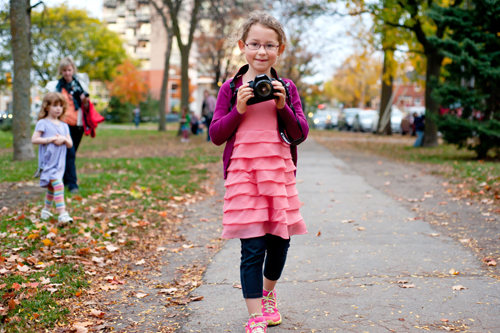
How does our neighbourhood look when you are two and a half feet tall? What’s important about your community when you are eight years old? (Hint: check out this web gallery.)
Ten families from Churchill Alternative School picked up their cameras and set off to explore the streets of Westboro through the lens, as part of the Kate Settle’s CLIC Children’s Photography Program.
KT had the opportunity to ask Settle, a Churchill parent and professional photographer, a bit about the photo walk.
KT: Where did you go? What kinds of things did you photograph during your walkabout?
KS: We met at Churchill School, and walked down the Ravenhill stairs, and made our way down the Byron Pathway and over to Maplelawn Garden. We had scheduled an hour, but many families stayed longer and continued photographing until we lost the light. We had an extended route planned if we had needed (ending at Bridgehead!) but the children were so absorbed in creating their photos that we moved quite slowly, wanting to give them all the space they needed.
There was no limit put on subject matter for this walk, and the families were encouraged to photograph whatever inspired them.
What kind of instruction, if any, did you give the kids? What kind of subject matter interested them the most?
Many of the children have participated in the CLIC Photography program through Churchill school, and had some photography instruction leading up to the walk. Before we set off that evening we chatted about basic principals like focusing your camera. The group was also encouraged to think about composition and changing their position, and to try using the macro settings on their cameras to get some nice close-ups with a shallower depth of field. As we walked we talked about what was interesting and important to them, and how they could capture that to tell a story.
The kids were drawn to anything that seemed remotely strange or out of place, as well as bright colours. Fall leaves and trees were a popular subject, and as we walked we spotted many of our kids looking up towering trees, or crouching down near piles of bright leaves. The boys in particular were interested in the oddities, such as a mitten on a fence, parents and friends making funny faces, the journeys of a Lego man in a big world.
Why is it important for kids to do this kind of activity? And how is working with kids different from working with adults?
I am a working photographer, which I love, but when something you love becomes the way to pay the bills, an element of the recreational “fun” aspect of that activity shifts. I don’t get out to play with my camera as much as I’d like, so last year I signed up for my first group photo walk. It took a while for the inspiration to start flowing, but once I let go of my preconceived limits I produced some of my very favourite images.
A photo walk is a fun, low pressure, and low cost way to spend some creative family time. It seemed like a logical step to involve families in some of thephotography work the children are doing at school, and the neighbourhood makes a great canvas for that. Children generally don’t feel the same limits I did on my first photo walk, and it’s often the kids who inspire the adults to let their creativity out of the box and to see things differently.
I see photography as a great equalizer. It’s completely accessible to anyone with any kind of camera in hand, regardless of abilities in other areas. For many children who, for reason of age, language, shyness, or diverse abilities are not able to express themselves in an adult world, a camera can provide a valuable communication tool, and a real window into their thoughts. Having something tangible, in the form of a photograph that you are proud of, that is a testament to your place in the world can be very powerful. I’m very passionate about providing tools to make this happen!
If you would like more information on CLIC please visit www.katesettlephotography.com
—
How do you raise snap happy kids?
In this digital age it’s relatively easy to spend an hour with a child, camera in hand, and ask them to simply capture what’s important to them. The results will be enlightening to you, exciting and empowering to them, and a keepsake for when you are both feeling nostalgic.
If you want to take things up a notch, consider talking to your kids about:
- Perspective: What happens if you take a photo lying on the ground?
- Composition: What’s the subject of your photo, and how could you frame that creatively?
- Depth: Try experimenting with a narrower depth of field by using the macro setting on your camera.
You could pick a theme for your own photo walk. Look for people, colours, food, whatever catches the eye and imagination. The possibilities are endless, and each photo walk you take will help you see the everyday in a new light.
